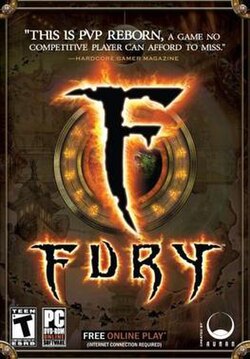Fury (video game): Difference between revisions
m Undid revision 420059891 by 68.42.156.122 (talk): -redundant comment. -unnecessary hatnote. |
No edit summary |
||
| Line 22: | Line 22: | ||
Fury further differentiated itself from traditional RPGs by making many of its spells and abilities activate instantly and lacking a [[cooldown]] period. The pace of gameplay thus tended to be faster than PvP combat in traditional RPGs. For example, spell-casters in Fury were sometimes not frozen in place when casting a spell, which allowed them to retreat and avoid obstacles that might otherwise have locked them in. |
Fury further differentiated itself from traditional RPGs by making many of its spells and abilities activate instantly and lacking a [[cooldown]] period. The pace of gameplay thus tended to be faster than PvP combat in traditional RPGs. For example, spell-casters in Fury were sometimes not frozen in place when casting a spell, which allowed them to retreat and avoid obstacles that might otherwise have locked them in. |
||
The game was initially well recieved in beta testing and during an pre-release event known as the Fury Challenge, however, many aspects of the game that the beta testers loved were changed between the end of the Fury Challenge and the public release version. To add to this, patching continued to set back the game. Developers would often ask players what they wanted from the game and then disreguard the answers they recieved. At the beginning of 2008, a large change was made to the game mechanics and the business plan of Fury. This made the game completely free to play, with the option of upgrading to the two previous payment options: retail price (a one time fee), and Immortal (monthly payments). Additionally, all players prior to this large patch were given Immortal status free for life. Many believe that this large patch, along with the lack of a proper introduction for new players and the obvious removal of a large revenue source marked the beginning of Fury's death. |
|||
A new business plan was drafted late in the game's life which would attempt to save the game. This plan included a match limit for free players and the possibility for skilled players to turn their skill into cash, however the servers shut down before this plan was ever implemented. |
|||
==Reception== |
==Reception== |
||
Revision as of 11:23, 2 September 2011
Fury (sometimes capitalised; FURY) was a player versus player (PvP) competitive online role-playing game (CORPG) / massively multiplayer online role-playing game (MMORPG) developed by Auran. It was released on 16 October 2007 and was shut down on 7 August 2008. This puts the total life of the game at a little less than 10 months.
Fury's focus on PvP combat differentiated it from traditional RPGs that center around player versus environment (PvE) content against non-player characters. However, like most RPGs, Fury used collectible equipment, skills, and a ranking mechanism for players. Fury used a method of matching equally ranked players from across the world in PvP matches, and was said to not always work well. [citation needed]
Fury further differentiated itself from traditional RPGs by making many of its spells and abilities activate instantly and lacking a cooldown period. The pace of gameplay thus tended to be faster than PvP combat in traditional RPGs. For example, spell-casters in Fury were sometimes not frozen in place when casting a spell, which allowed them to retreat and avoid obstacles that might otherwise have locked them in.
The game was initially well recieved in beta testing and during an pre-release event known as the Fury Challenge, however, many aspects of the game that the beta testers loved were changed between the end of the Fury Challenge and the public release version. To add to this, patching continued to set back the game. Developers would often ask players what they wanted from the game and then disreguard the answers they recieved. At the beginning of 2008, a large change was made to the game mechanics and the business plan of Fury. This made the game completely free to play, with the option of upgrading to the two previous payment options: retail price (a one time fee), and Immortal (monthly payments). Additionally, all players prior to this large patch were given Immortal status free for life. Many believe that this large patch, along with the lack of a proper introduction for new players and the obvious removal of a large revenue source marked the beginning of Fury's death.
A new business plan was drafted late in the game's life which would attempt to save the game. This plan included a match limit for free players and the possibility for skilled players to turn their skill into cash, however the servers shut down before this plan was ever implemented.
Reception
| Publication | Score |
|---|---|
| GameSpy | 2.5/5 |
| GameSpot | 4.5/10 |
| IGN | 6.5/10 |
| Game Informer | 5/10 |
| Eurogamer | 3/10 |
| GameZone | 4.6/10 |
| PALGN AU | 7/10 |
| NZGamer | 5/10 |
| 1UP.com | 4/10 |
| Cheat Code Central | 3.1/5 |
| PC Gamer | 61/100 |
Fury received below average reviews from major gaming websites, having a 50.8% rating on GameRankings.[2]
- GameSpot gave the game 4.5 out of 10, highlighting its poorly optimized engine, and its clumsy and chaotic gameplay.[3]
- IGN gave a 6.5 out of 10, however ultimately criticized similar concepts, such as excessive amounts of useless skills, too many NPCs and minimal longevity.
References
- ^ MobyGames, Fury credits page at mobygames.com, retrieved 28 December 2008
- ^ Game Rankings – Fury Reviews
- ^ GameSpot – Fury Review

